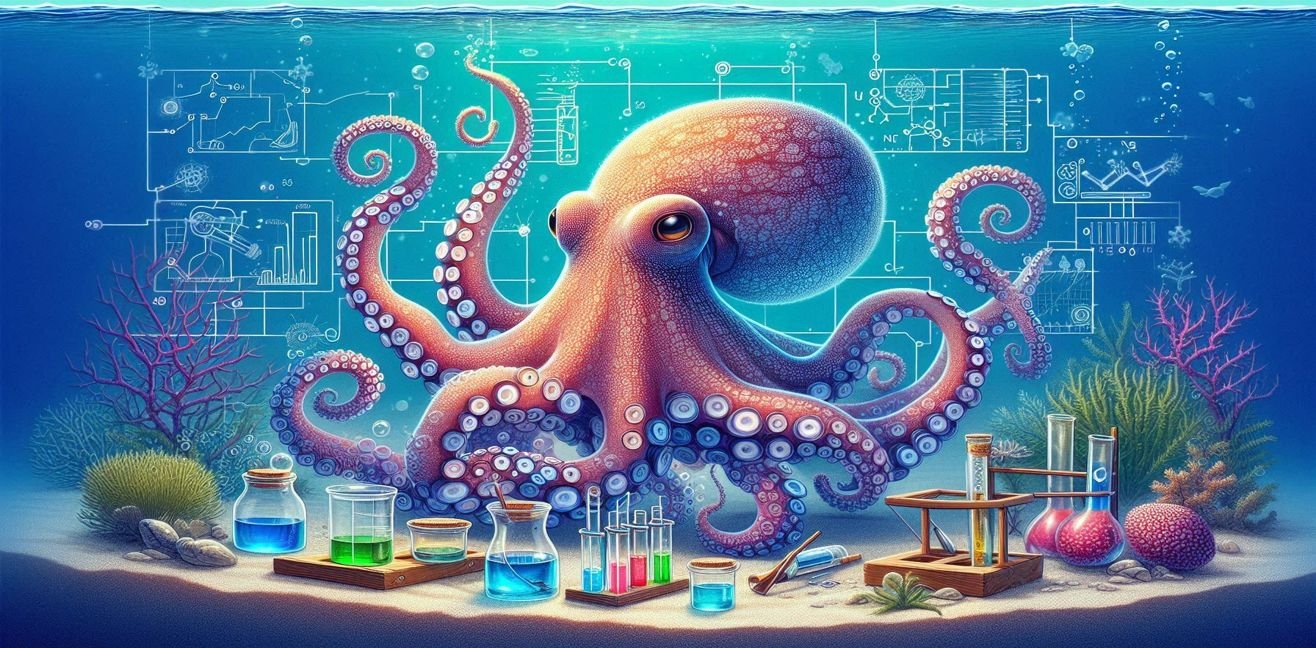Imagine, my love… you have eight arms, and each one moves independently as if it had its own brain. 😲💫 That’s exactly what octopuses do! These marine creatures possess incredible problem-solving abilities thanks to their central nervous system and peripheral neuron networks, making them one of the smartest animals in the ocean. 🌊✨
1. Neuroanatomy and Nervous System Structure 🧠
Octopuses have a central brain in their head, but each arm contains roughly 500 million neurons. 🖐️⚡ This is comparable to the number of neurons in the central brain and allows the arms to perform complex movements independently.
- Central Brain: Responsible for motor control, learning, memory, and coordination.
- Arm Neuron Networks: Each arm can grasp objects, recognize shapes, and make independent decisions.
- Functional Division: The central brain handles strategy and planning, while the arm neurons are optimized for rapid responses and simultaneous multitasking.
This structure can be thought of as a distributed neural network model, inspiring robotic and AI systems. 🤖✨
2. Problem Solving and Learning Capacity 🧩
Octopuses are renowned for solving jars, navigating mazes, and completing complex puzzles in laboratory experiments.
- Short-Term Memory: Experiments show octopuses can retain information for a few minutes to several hours.
- Long-Term Memory: With training, they can remember specific tasks for days or even weeks.
- Agent-Based Problem Solving: Octopuses analyze environmental cues and develop new solutions. For example, they can learn to open a jar they’ve never encountered before.
Scientifically, this is classified as trial-and-error learning, indicating a high level of cognitive ability. 🧠✨
3. Motor Control and Arm Coordination 🦾
The unique flexibility of octopus arms is enabled by their nervous system:
- Hydraulic Muscle System: Muscles and water-filled chambers inside the arms allow precise and powerful movements. 💪💧
- Proprioception: Each arm senses the position and pressure of objects around it.
- Independent Coordination: While one arm grabs food, another can perform a different task simultaneously, allowing decision-making independent of the central brain. ⚡
These motor control capabilities serve as a model for multi-arm robotic systems and human-machine interaction. 🤖
4. Sensory Perception and Environmental Interaction 🌊
Octopuses use advanced sensory systems to interact with their environment:
- Haptic Perception: Receptors in the arms can detect textures and analyze shapes. 🖐️
- Chemical Sensing: Taste and smell receptors on the arm surface detect food and dangers. 🍤⚠️
- Visual Perception: Large eyes provide high-resolution detection of prey and predators. 👁️
5. Intelligence and Behavioral Flexibility 🧠💡
Observations in labs and in nature reveal octopus intelligence and strategic behaviors:
- Hunting Tactics: They can use their own shadow to ambush prey or camouflage themselves. 🎨
- Escape Artistry: They can slip through narrow openings and confuse predators with rapid color changes. 🕳️
- Play and Exploration: Some species interact with toys in labs, manipulating objects—a sign of cognitive flexibility. 😸
6. Scientific Significance and Inspiration 🌟
Octopuses serve as model organisms in neuroscience, artificial intelligence, robotics, and cognitive science:
- Distributed Control Systems: Independent arm control inspires autonomous robotic arms. 🤖
- Memory and Learning Mechanisms: Experiments reveal interactions between central and peripheral learning. 🧠
- Motor and Sensory Research: Hydraulic muscle systems and proprioception improve precision manipulation technologies. 💪
Lessons from Octopuses 💌
- Flexible thinking: Sometimes distributed intelligence outperforms centralized control. 🔬
- Multitasking and independent decision-making: Solving multiple problems simultaneously enhances success. 🌀
- Nature as inspiration: Octopuses guide scientists in robotics and AI innovation. 🌟
- Humor and play: Fun and exploration are integral to learning. 😸




